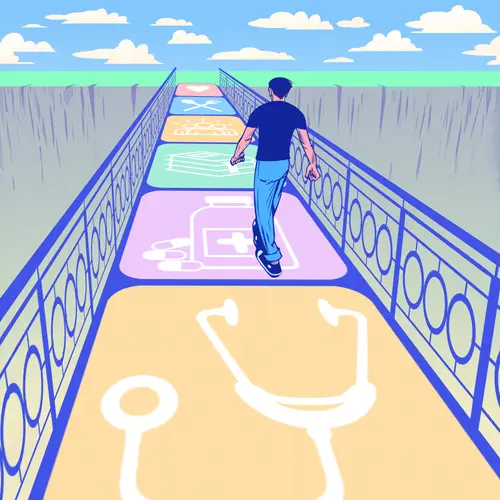When Ramona Richman's older sister was diagnosed with high cholesterol, Richman wasn't worried about her own risk. The San Francisco Bay Area stay-at-home mom had her weight under control and assumed that her diet was healthy. So when her doctor broke the news that she, too, had high cholesterol, she was shocked. Her reading of 269 mg/dL was well over the desirable level of less than 200 mg/dL. "My sister had high cholesterol and went on medication, so I imagine that it's a genetic thing," Richman, 48, says.
Genes can be a factor in high cholesterol, but so can being overweight, being physically inactive, and eating foods loaded with saturated fat and cholesterol. The liver manufactures all the cholesterol a body needs, but many people get substantial amounts from their diet. Regardless of the cause, high cholesterol poses dangers. It plays a major role in the development of atherosclerosis, or hardening and narrowing of the arteries, which in turn raises the risk of heart attack and stroke.
When doctors talk about high cholesterol, they don't mean the amount of cholesterol a person gets from food, but rather how much of the substance is circulating in the blood. With atherosclerosis, the specific culprit is elevated LDL cholesterol, the "bad" kind associated with "increased risk of heart attacks and dying of heart disease," says Antonio M. Gotto Jr., MD, a professor of medicine at Weill Medical College of Cornell University and an expert on cholesterol and atherosclerosis.
Atherosclerosis is a gradual process. "It can start early in life," Gotto says. Fatty streaks can show up in adolescent arteries, and autopsies on men in their 20s have revealed "significant plaque in coronary arteries," he adds. "It doesn't just occur overnight." Over time, this plaque buildup can turn into a serious health threat, boosting risk of heart attack and stroke -- as people enter their 40s, 50s, and 60s, Gotto says. "Coronary disease shows a sharp increase during the 50s in men, and the late 50s and 60s in women."
How Arteries Harden
How does atherosclerosis begin to happen exactly? In a healthy artery, the inner lining, or endothelium, is smooth and intact. But disease or injury -- including diabetes, high blood pressure, and high cholesterol -- can damage this lining, paving the way for atherosclerosis.
Scientists aren't sure how high cholesterol injures arteries, Gotto says, but he explains one theory: The fatty acids carried by LDL become oxidized and injure blood vessel walls. "The higher the level of LDL circulating in the blood, the more the wall gets injured." An inflammatory reaction ensues, Gotto says. "The blood vessel responds by a reaction to injury. It treats this as if you scratched your finger."
Atherosclerosis begins when white blood cells move into the lining and artery wall. They transform into foam cells, which accumulate fat and cholesterol. Other substances, such as calcium, also collect at the site. Eventually, an atherosclerotic plaque, or atheroma, forms.
These plaques thicken and harden the artery wall and bulge into the bloodstream to reduce or block blood flow. When an atheroma ruptures, it can trigger a blood clot leading to heart attack or stroke. Most commonly, atherosclerosis affects the left anterior descending coronary artery [one of the main arteries of the heart], the carotid arteries in the neck, and the abdominal aorta, Gotto says.
Lowering Your Cholesterol
While LDL is harmful, HDL, a "good" form of cholesterol, helps arteries. Besides quieting down inflammation in damaged arteries, "it blocks the oxidation of LDL," Gotto says, "and we think that HDL has the ability to pull some of the cholesterol out of the cells on the arterial wall and transport it back to the liver, where the body can get rid of it. The higher the level of HDL, the lower the risk of heart attacks and cardiovascular disease."
Know your cholesterol numbers, he adds. "It's better to talk to your doctor about atherosclerosis before you get symptoms, and unfortunately for many people, the first symptom may be the fatal one if they have sudden cardiac death or cardiac arrest."
Gotto suggests people talk to their doctor about risk factors for atherosclerosis while still in their 20s and get a blood test to check cholesterol levels. Before age 40, get a cholesterol test every three years, Gotto says, and after age 40, test annually.
When Richman got her unsettling results, she replaced whole-milk products with low-fat dairy foods. She ate more heart-healthy salmon. She also began walking for 40 minutes, five times each week. The changes have paid off slowly. Her cholesterol readings have dropped a bit, from a high of 269 to 247, and she hopes to get her reading low enough to avoid taking cholesterol medications.
"At the beginning, it was 'Oh, wow, I'm sick,'" she says. "But I was able to start getting my levels down, so that's been very encouraging."
Could You Have Atherosclerosis?
You may be at a higher risk of atherosclerosis if you:
- Have high levels of LDL cholesterol in the blood
- Have high blood pressure
- Have diabetes
- Are obese
- Are physically inactive
- Smoke
- Are older
- Have a family history of early atherosclerosis
- Are male
Originally published in the March/April 2008 issue ofWebMD the Magazine.

